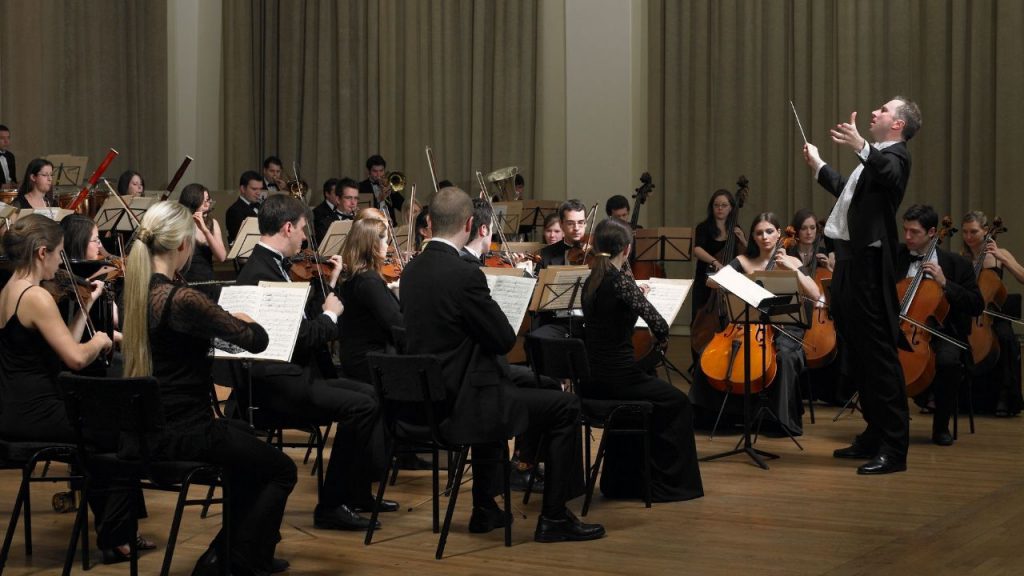The Boston Symphony, the Philadelphia Orchestra and the New York Philharmonic are some of the most celebrated groups. Each of these is similar in repertory, instrumentation and audience profile. What, then, makes them different, one from another? What’s the difference between symphony vs orchestra vs philharmonic?
What Is a Symphony?
The etymology of the word “symphony” yields a broad definition. The ancient Greeks and Romans used the word “symphonia” to mean a unison of sounds or concord (i.e. agreement) of sounds. These descriptions apply to most of the music written since the beginning of time. In fact, the same word was affixed to compositions that had little in common with each other. James Bennett II, a classical music writer, contends that everything changed with Franz Josef Haydn.
Composing in the 18th/19th centuries, Haydn issued a large volume of works that he called symphonies. In essence, he dominated the market, making the structure of his compositions a gold standard in terms of what defines a symphony. Larger ensembles that focused on these types of works eventually assumed the label of symphony orchestra, although they did not necessarily limit their playing to symphonies. This is why symphony vs. orchestra represents something of a false choice. Atlanta, Chicago, and San Francisco all have symphony orchestras of over 100 musicians.
What Is an Orchestra?
Again, taking the most general definition first, an orchestra can be any group of instrumentalists, large or small. The word’s Greek origins refer to a section of the stage — and later a theater section reserved for dignitaries. However, the term evolved from a place to an assemblage of musicians.
Dance bands of the 1930s and 40s called themselves orchestras. Nevertheless, common usage refers to classical ensembles made up of strings, woodwinds, brass and percussion instruments, with the string section as the most identifiable component. This standard line-up conforms to most of the music written during the Baroque, Classical, Romantic and Modern periods.
From the very fact that orchestras emerged to play symphonies, among other works, it is clear that the symphony vs orchestra opposition is inaccurate. Worth noting is that some major metropolitan orchestras keep the simplest names, like the Philadelphia Orchestra, Cleveland Orchestra and the Minnesota Orchestra.
What Is a Philharmonic?
There is actually no such thing as a philharmonic. Sometimes, however, the word is used as shorthand for philharmonic orchestra.
Philharmonic is a word best broken down to understand its substance: philia refers to love or affection for someone or something; armonia indicates things — sounds in this case — fitting together. So, as philosophy means love of wisdom, philharmonic stands for the love of music. Accordingly, there is no tension between philharmonic vs symphony. Neither is philharmonic vs orchestra a legitimate distinction since one describes the other.
Orchestras like the New York Philharmonic, Los Angeles Philharmonic, and Vienna Philharmonic can all be called symphony orchestras, their official names notwithstanding. Those serving major cities ordinarily have 100 members more or less, with the same sections and instruments represented as those orchestras with “symphony” in their names.
Symphony vs Orchestra vs Philharmonic: Is There a Difference?

As demonstrated above, orchestras throughout the United States and the world go by different names but share the same music, constituent instrumentation, and slice of the music-loving public. They play what Leonard Bernstein once called “exact music,” i.e. played the exact same way — note for note, rhythm for rhythm — each and every time.
They all play symphonies, overtures ballet music, and more; all contain the same sections of instruments; and all play to a demographic that appreciates the rigor of this music. Yes, they will add a saxophone now and then for Gershwin or Ravel. Likewise, they will shrink the number of active players for a Bach concerto or Monteverdi operatic overture. These tweaks, however, do not change their regular musician rosters, which all look remarkably similar, budgets allowing.
Conclusion
By now it is clear that there is no substantial difference between a philharmonic vs symphony orchestra. Patrons should never let a name dictate which orchestra deserves their devotion. Excellent musicianship; powerful interpretations by conductors; and, more practical for live performance, geographic proximity is the best benchmarks for music lovers to consider.
Table of Contents






